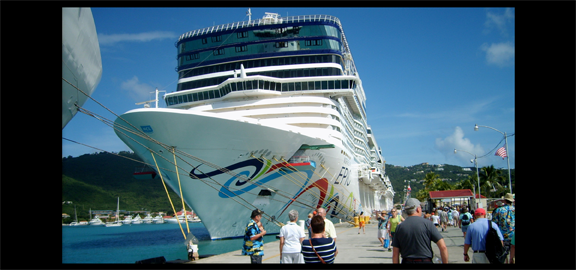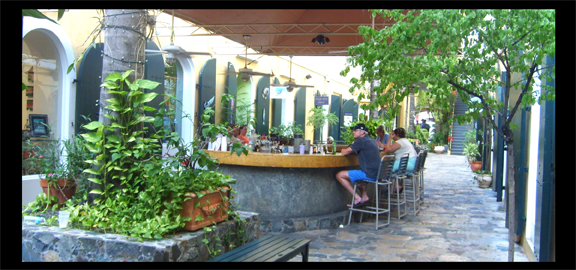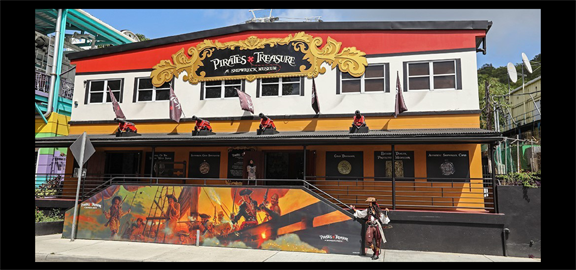
By Mysterious Destinations Staff
On any given day of the winter tourist season, the picturesque seaside town of Charlotte Amalie on the isle of St. Thomas in the US Virgin Islands is crowded with visitors arriving on sleek jets from the nearby airport and elegant cruise liners from two piers in the tranquil bay.
Few, if any, of these sightseers, looking across the anchorage to Hassel Island only several hundred yards from shore, would know that somewhere beneath the clear blue waters within their view may lie a lost hoard of pirate treasure: 24,000 pounds of silver.
A Pirate Visits Charlotte Amalie
According to Isidor Paiewonsky’s 1961 book The Burning of a Pirate Ship, the story begins in 1683 when the buccaneer frigate La Trompeuse (French for “deception”), under the command of Jean Hamlin, entered the harbor loaded to the gunnels with loot they had taken during a recent cruise. Hamlin, a Frenchman, was not a pirate given to polite acquisition of his captured prizes. Instead, he used thumbscrews, both on fingers and “privys,” according to one report, in an effort expedite the acquisition of information as to where valuables could be located on the captured vessel.
Hamlin had left quite a trail of destruction, much to the alarm of most local authorities, and had therefore come to the attention of His Majesty’s Royal Navy, which had sent the English warship HMS Francis to pursue and capture him.
However, circumstances in St. Thomas were quite the opposite of other nearby Caribbean islands, according to a 2011 posting by Stuart Thornton on nationalgeographic.org.

The island was under Danish control, and the governor, Adolph Esmit, had no problems with, or prying questions for, sea rovers looking to trade and spend on his island.
Hamlin was aware of this, and when he dropped anchor somewhere in the harbor at Charlotte Amalie, he came ashore ready to do business. He may have known, or rightly assumed, that English authorities might be after him, which likely prompted a brisk exchange with Esmit, and a quick transfer of goods from ship to shore.
Large warehouses with heavy wooden doors lined the dockside streets in those days, and many of these can still be seen today, although they presently house trendy shops and unique restaurants.
The quay of Charlotte Amalie must have been a busy place for at least several days as pirate crews ferried loot aboard rowboats from ship to shore and Danish workers on the docks quickly hustled the treasure into nearby warehouses.
24,000 Pounds of Silver
The cargo successfully transferred into Esmit’s custody is said to have included over 2,000 pounds of gold, but 24,000 pounds of silver remained in the ship’s treasure room awaiting transfer, according to reports.
A document written by St. Thomas resident Andreas Brock at the time, and printed in Paiewonsky’s book, stated the silver was still aboard on July 30, 1683, when the HMS Francis sailed into the harbor, ready to capture Hamlin and the La Trompeus.
English Captain Charles Carlile likely thought he had caught the sea rovers at a disadvantage, still at anchor and not ready for a fight. He engaged the pirate vessel in a sharp cannon exchange, when he suddenly realized that shore batteries under the Danish had opened fire on him. Now that he was at the disadvantage, Capt. Carlile quickly withdrew to a position beyond range of the Danish guns, and considered his next option.
Capt. Carlile sent an emissary ashore with a letter to the governor, but received no cooperation. So, he came up with another plan.
Several days later, on July 31, Capt. Carlile assembled an armed party of 14 men and divided them between two long boats.
Despite the growing darkness and likely a stealthy approach, the English were discovered by the pirates, who engaged the two boats with musket fire. The English returned fire, effectively enough to drive the remaining pirates off the ship. Capt. Carlile’s detachment then succeeded in boarding the pirate ship.

Destruction of the La Trompeuse
There is no mention in documents, including Capt. Carlile’s journal, that the detachment searched the captured frigate for any remaining treasure. Instead, they set fire to the La Trompeuse and quickly regained their boats. They rowed out a short distance and stood by while the fire began to engulf the vessel, ensuring no pirates were able to re-board the ship and control the fire. There was a massive explosion when the flames breached the ship’s powder room, so large that another pirate vessel, the Trinity, also became engulfed in flames. The charred, shattered hulk of La Trompeuse had already slipped beneath the ocean’s surface. The Trinity burned to the waterline and sunk as well.
If indeed there was 24,000 pounds of silver still aboard the La Trompeuse, it is unknown if it all settled to the harbor bottom in one pile, or if it was blown in all directions by the exploding powder.
However, the greater mystery that still confounds historians and treasure hunters alike, is the exact location of the La Trompeuse’s anchorage.
In 1990 a treasure hunter claimed to have found the wreckage, but no proof was ever established regarding that claim. Presently there is a group searching for the lost silver of the La Trompeuse, but they aren’t sharing any information.

For modern day visitors seeking buccaneer loot in Charlotte Amalie, the best place to look is at The Pirates Treasure Museum located near the Havensight Cruise Pier on the south side of the bay, just across the street from the WICO dock and next to Paradise Point Tramway. The museum is full of all kinds of treasure, both monetary and historic. Perhaps, a few questions to the staff might reveal new secrets about the mystery of pirate silver still aboard the La Trompeuse, and the elusive treasure, somehow still lost under the clear, turquoise waters of the harbor at Charlotte Amalie.
Presently, due to COVID 19 there are various and changing travel restrictions for both cruise ships and airport arrivals in St. Thomas.
These issues have also apparently led to a change in hours at the The Pirates Treasure Museum. According to their Facebook page, “We are re-open and allowing private, VIP access to the Pirates Treasure Museum! For your party of up to 10 guests, you can explore all of the exciting exhibits and amazing attractions of our museum for up to 90 minutes, which includes time in our gift shop, searching for trinkets or historical treasures!” Arrangements may be made by telephone at 340-775-9575.
If you would like to be notified of changes in travel restrictions for St. Thomas, please join us as a subscriber… It’s free, and subscribers get follow-up notifications on all of our articles! Click here to subscribe.

